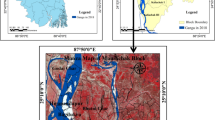Abstract
Dams and their reservoirs, constructed to manage the water scarcity problems of a region, sometimes lose whole or part of their functionality due to sedimentation. This issue, seen as a negative impact as far as reservoir life and its purpose is concerned, can be a boon to the construction industry, by providing a highly demanding construction material in the form of sand dredged from the reservoirs. Malampuzha reservoir, a multipurpose reservoir in the South Indian state of Kerala, is also losing considerable part of its storage due to siltation. This paper assesses the rate of sedimentation in Malampuzha reservoir, through bathymetric survey and suggests measures for utilization of the removable sediment. Our analysis has shown that the reservoir capacity is reduced from 226 to 205.19 Mm3; a reduction in capacity of 20.81 Mm3 in 55 years. The rate of sedimentation of the reservoir is estimated as 16.95 mm/year. The dead storage capacity of the reservoir has reduced to 47.5 % from the original at present. The composition of deposited sediments is also identified, based on which its productive use is recommended.







Similar content being viewed by others
References
Banerji S, Lal VB (1971) Council for Scientific and Industrial Research, Paper from a symposium ‘Water in Man’s Life’ 40(A), pp 5–6
Batuca DG, Jordan JM (2000) Silting and de-silting of reservoirs, Chapter 9, de-silting of reservoirs—sediment removal techniques and technologies
Centre for Water Resources Development and Management (2010) Characterization and spatial distribution of sediment deposition in the Malampuzha reservoir (unpublished report)
De Vente J, Poesen J, Verstraeten G (2004) Evaluation of reservoir sedimentation as a methodology for sediment yield assessment in the Mediterranean: challenges and limitations. SCAPE Soil Conservation and Protection for Europe: Briefing Papers, Second SCAPE Workshop, Cinque Terre, Italy, 13–15 April 2004
Elçi S, Bor A, Calıskan A (2009) Using numerical models and acoustic methods to predict reservoir sedimentation. Lake Reserv Manag 25(3):297–306
Environment Protection Authority (2001) Guidelines for dredging, best practice environmental management, Australia Publication: 691 ISBN: 0-7306-75785
Goel MK, Jain SK, Agarwal PK (2002) Assessment of sediment deposition rate in Bargi Reservoir using digital image processing. Hydrol Sci J 47(S1):S81–S92
Gopinath G (2010) Sediment stratification and bathymetric survey using sediment echo sounder in reservoirs and shallow marine areas. Curr Sci 99(12):1821–1825
Hwang JS, Lai JS (1996) Sedimentation problems in PWCB reservoirs in Taiwan. In: International conference on reservoir sedimentation, Fort Collins, CO, USA, V(3), pp 1475–1482
Jagadeeswara Rao P, Harikrishna P, Surya Prakasa Rao B (2006) Studies on silt deposition in Gambhiram Reservoir—a remote sensing approach. J India Geophys Union 10(4):285–292
Jain SK, Singh P, Seth SM (2002) Assessment of sedimentation in Bhakra Reservoir in the western Himalayan region using remotely sensed data. Hydrol Sci J 47(2):203–212
Jennifer L, Lukens (2000) National coastal program dredging policies, an analysis of state, territory & commonwealth policies, related to dredging & dredged material management, Vol I(II), OCRM/CPD Coastal Management Program Policy Series, Technical document, pp 00–02
Kothyari UC (1996) Erosion and sedimentation problems in India. In: Walling DE, Webb DW (eds) Erosion and Sediment Yield: Global and Regional Perspectives. Proceedings of the Exeter symposium, IAHS Publ. 236, pp 531–540
Mahmood K (1987) Reservoir sedimentation: impact, extent and mitigation. World Bank Technical Paper No. 71, World Bank, Washington, DC
Morris GL, Fan J (2010) Reservoir sedimentation handbook: design and management of dams, reservoirs and watershed for sustainable use, Ver 1.04. McGraw-Hill, New York
Mujabar PS, Chandrasekar N (2013) Shoreline change analysis along the coast between Kanyakumari and Tuticorin of India using remote sensing and GIS. Arab J Geosci 6:647–664
Mukherjee S, Veer V, Tyagi SK, Sharma V (2007) Sedimentation study of Hirakud Reservoir through remote sensing techniques. J Spatial Hydrol 7(1):122–130
Mulatu CA (2012) Analysis of reservoir sedimentation process using empirical and mathematical method: case study—Koga Irrigation and Watershed Management Project; Ethiopia. Nile Basin Water Sci Eng J 5(1):1–13
Odhiambo BK, Boss SK (2004) Integrated echo sounder, GPS and GIS for reservoir sedimentation studies examples from two Arkansas Lakes. J Am Water Resour Assoc Res 40(4):981–997
Padmaja KV, Wani SP, Lav A, Sahrawat KL (2006) Economic assessment of de-silted sediment in terms of plant nutrients equivalent: a case study in the Medak district of Andhra Pradesh: International Crops Research Institute for the Semi-Arid Tropics. 24 SAT e Journal ejournal.icrisat.org
Public Works Department (PWD) (1950) Report on the Malampuzha Project, Government of Madras
Rathore DS, Choudhary A, Agarwal PK (2006) Assessment of sedimentation in Hirakud Reservoir using remote sensing technique. J Indian Soc Remote Sens 34(4):377–383
Riebsame WE, Meyer WB, Turner BL II (1994) Modeling land-use and cover as part of global environmental change. Clim Change 28:55–64
Savitha CC, Sumesh EV (2010) Reclamation and economic utilization of sediment materials from man-made reservoirs—a case study on Malampuzha reservoir 22nd Kerala Science Congress. Kerala Forest Research Institute, Peechi, pp 359–362
Sumi T, Hirose T (2009) Accumulation of sediment in reservoirs. In: Takahasi Y (ed) Water storage, transport and distribution. UNESCO-IHE and EOLSS Publishers Co. Ltd., Paris, France, pp 224–252
Victor M, Delgado Jr (2010) The effectiveness of de-silting the Pulangi IV Hydropower Plant’s Reservoir. In: The 18th conference of the electric power supply industry (CEPSI 2010)
Zhou JJ, Zhang M, Chao HQ (2011) Removing coarse sediment by sorting of reservoirs. Sci China Technol Sci 54(4):903–913
Acknowledgments
The authors are grateful to the Executive Director of Centre for Water Resources Development and Management (CWRDM), Kozhikode for the facilities provided, to prepare this paper.
Author information
Authors and Affiliations
Corresponding author
Rights and permissions
About this article
Cite this article
Gopinath, G., Ashitha, M.K. & Jayakumar, K.V. Sedimentation assessment in a multipurpose reservoir in Central Kerala, India. Environ Earth Sci 72, 4441–4449 (2014). https://doi.org/10.1007/s12665-014-3344-0
Received:
Accepted:
Published:
Issue Date:
DOI: https://doi.org/10.1007/s12665-014-3344-0




